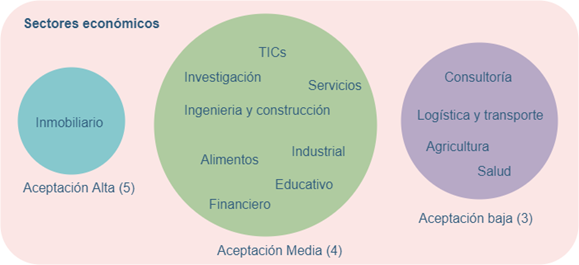Application of technology transfer for the validation of the relevance of software developments for the formulation of research and innovation projects
DOI:
https://doi.org/10.33131/24222208.403Keywords:
Multimedia platform, MSME, Technology Transference, Logical Logical Framework MethodologyAbstract
Currently, Information and Communication Technologies (ICT), and knowledge management, are key tools for innovation processes in companies; Therefore, instruments such as virtual platforms and software developments are fundamental in the digital transformation to improve the productivity and competitiveness of MSMEs, in the same way, companies continuously seek process improvements to develop innovative products, applying technologies emerging and generating results and products that can be appropriated by the market. However, many organizations lack the knowledge or instruments to implement innovation processes such as the identification and formulation of research and technological development projects, so it is necessary to use software tools that can contribute to these activities in a simple, agile way. and user-friendly and that these in turn are appropriated by the entrepreneurs in their different processes in an effective and efficient way and not only remain in good initiatives without implementation within the organization. In this context, this article describes the results of the technology transfer on the tool: “Interactive Guide for the development of innovation projects (GIDPI)”, carried out to the MSMEs of Medellín and its Metropolitan Area. The objective of said transfer was, through a random stratified sample with proportional fixation, to validate the relevance of the tool in the development of innovation projects within organizations using the Logical Framework Methodology. The result of this transfer allowed the measurement of characteristics such as the functionality, applicability, intentionality, usability and user experience of the GIDPI platform through the perceptions received from entrepreneurs, highlighting the relevance of the platform for the formulation of innovation projects and the coherence with the requirements of the entities that finance research and technological development. In this sense, it can be seen how technology transfer processes contribute to the validation of innovative products such as software developments and promote knowledge management inside and outside organizations.
Downloads
References
D. Sarpong, A. AbdRazak, E. Alexander, y D. Meissner, «Organizing practices of university, industry and government that facilitate (or impede) the transition to a hybrid triple helix model of innovation», Technol. Forecast. Soc. Change, vol. 123, pp. 142-152, oct. 2017, doi: 10.1016/j.techfore.2015.11.032.
D. D. Dereli, «Innovation Management in Global Competition and Competitive Advantage», Procedia - Soc. Behav. Sci., vol. 195, pp. 1365-1370, jul. 2015, doi: 10.1016/j.sbspro.2015.06.323.
M. A. Muñoz Nieto, D. R. Rojas Blair, C. C. Córdoba Vanegas, y J. A. Patiño Murillo, «Análisis comparativo del índice de Libertad económica de 2019 entre Colombia y otros países de Suramérica», Rev. CINTEX, vol. 25, n.o 1, pp. 68-83, 2020, doi: https://doi.org/10.33131/24222208.360
R. Ramírez, La investigación científica y tecnológica y la innovación como motores del desarrollo humano, social y económico para América Latina y el Caribe, 3.a ed. en Conferencia Regional de Educación Superior. Córdoba, Argentina: UNESCO, 2018. [En línea]. Disponible en: https://unesdoc.unesco.org/ark:/48223/pf0000372642
L. F. Beltran Morales, M. A. Almendarez, y D. J. Jefferson, «El efecto de la innovación en el desarrollo y crecimiento de México: una aproximación usando las patentes», Probl. Desarro. Rev. Latinoam. Econ., vol. 49, n.o 195, sep. 2018, doi: 10.22201/iiec.20078951e.2018.195.63191.
J. C. Lopera Lopera, L. F. Avalos Hincapié, y E. A. Duque Grisales, «Alternativa de financiación basada en titularización para la producción de plátano en el Urabá antioqueño», Rev. CINTEX, vol. 24, n.o 1, pp. 41-50, dic. 2019, doi: https://doi.org/10.33131/24222208.343
G. Rubio Guerrero, «Perspectiva multivariante de los pronósticos en las pymes industriales de Ibagué (Colombia)», Rev. Fac. Cienc. Económicas, vol. 25, n.o 2, sep. 2017, doi: 10.18359/rfce.3067.
S. M. Velásquez Restrepo, A. A. Pino Martínez, E. J. Restrepo Zapata, J. J. Castro Maldonado, y N. E. Viana Rúa, «Herramienta interactiva para apoyar la capacitación en formulación de proyectos bajo la metodología de marco lógico para las Mipymes del área metropolitana de Medellín», Rev. Estrateg. Organ., vol. 6, n.o 2, ago. 2018, doi: 10.22490/25392786.2473.
F. D. J. Franco Cuartas, «Estructura y evolución del sistema financiero colombiano de la banca comercial a la banca de inversión», Rev. MODUM, vol. 1, pp. 13-34, ago. 2018.
S. Londoño Marín, J. A. Londoño Gallego, J. J. Castro Maldonado, y J. A. Patiño Murillo, «Guía interactiva para el desarrollo de proyectos bajo la Metodología de Marco Lógico», Rev. Espac., vol. 39, n.o 47, p. 25, 2018.
Herdiana Dyah Susanti, Dian Arief Pradana, y Robit Nurul Jamil, «Triple Helix Synergy for Development and Enhancing Competitiveness of SMEs», Br. Int. Humanit. Soc. Sci. BIoHS J., vol. 2, n.o 1, pp. 321-327, mar. 2020, doi: 10.33258/biohs.v2i1.195.
K. Pineda Márquez, M. E. Morales Rubiano, y M. C. Ortiz Riaga, «Modelos y mecanismos de interacción universidad-empresa-estado: retos para las universidades colombianas», Equidad Desarro., n.o 15, pp. 41-67, ene. 2011, doi: 10.19052/ed.193.
L. M. Ranga, J. Miedema, y R. Jorna, «Enhancing the innovative capacity of small firms through triple helix interactions: challenges and opportunities», Technol. Anal. Strateg. Manag., vol. 20, n.o 6, pp. 697-716, nov. 2008, doi: 10.1080/09537320802426408.
R. Gómez Giraldo y L. M. Jaramillo Terán, «Propuesta de laboratorio de certificación en la norma ISO 29119 de pruebas de calidad de software en el Centro de Servicios y Gestión Empresarial del SENA», Rev. CINTEX, vol. 24, n.o 2, pp. 46-54, dic. 2019, doi: https://doi.org/10.33131/24222208.350
E. Carvajal, C. Chalarca, R. A. Arbelaez Perez, y E. Duque Grisales, «Responsabilidad Social de las entidades financieras colombianas en tiempos de covid-19», Rev. CINTEX, vol. 25, n.o 2, pp. 51-66, dic. 2020, doi: https://doi.org/10.33131/24222208.364
R. Hernández Sampieri y C. P. Mendoza Torres, Metodología de la investigación: las rutas cuantitativa, cualitativa y mixta, First edition. México: McGraw-Hill Education, 2018.
H. Lorentz, O.-P. Hilmola, J. Malmsten, y J. S. Srai, «Cluster analysis application for understanding SME manufacturing strategies», Expert Syst. Appl., vol. 66, pp. 176-188, dic. 2016, doi: 10.1016/j.eswa.2016.09.016.
C. Mircioiu y J. Atkinson, «A Comparison of Parametric and Non-Parametric Methods Applied to a Likert Scale», Pharmacy, vol. 5, n.o 4, p. 26, may 2017, doi: 10.3390/pharmacy5020026.
L. South, D. Saffo, O. Vitek, C. Dunne, y M. A. Borkin, «Effective Use of Likert Scales in Visualization Evaluations: A Systematic Review», Comput. Graph. Forum, vol. 41, n.o 3, pp. 43-55, jun. 2022, doi: 10.1111/cgf.14521.
L. Leydesdorff, «Triple Helix of University-Industry-Government Relations», en Encyclopedia of Creativity, Invention, Innovation and Entrepreneurship, E. G. Carayannis, Ed., Cham: Springer International Publishing, 2020, pp. 2356-2364. doi: 10.1007/978-3-319-15347-6_452.
E. Duque-Grisales, C. Vargas-Vargas, J. Patiño-Murillo, J. Gonzalez-Ruiz, y M. Becerra, «Project financing through public-private partnerships in Colombia: A look inside of 4G highway concessions», J. Appl. Eng. Sci., vol. 19, n.o 3, pp. 757-767, 2021, doi: 10.5937/jaes0-29044.

Downloads
Published
Versions
- 2021-08-29 (2)
- 2024-04-15 (1)
How to Cite
Issue
Section











